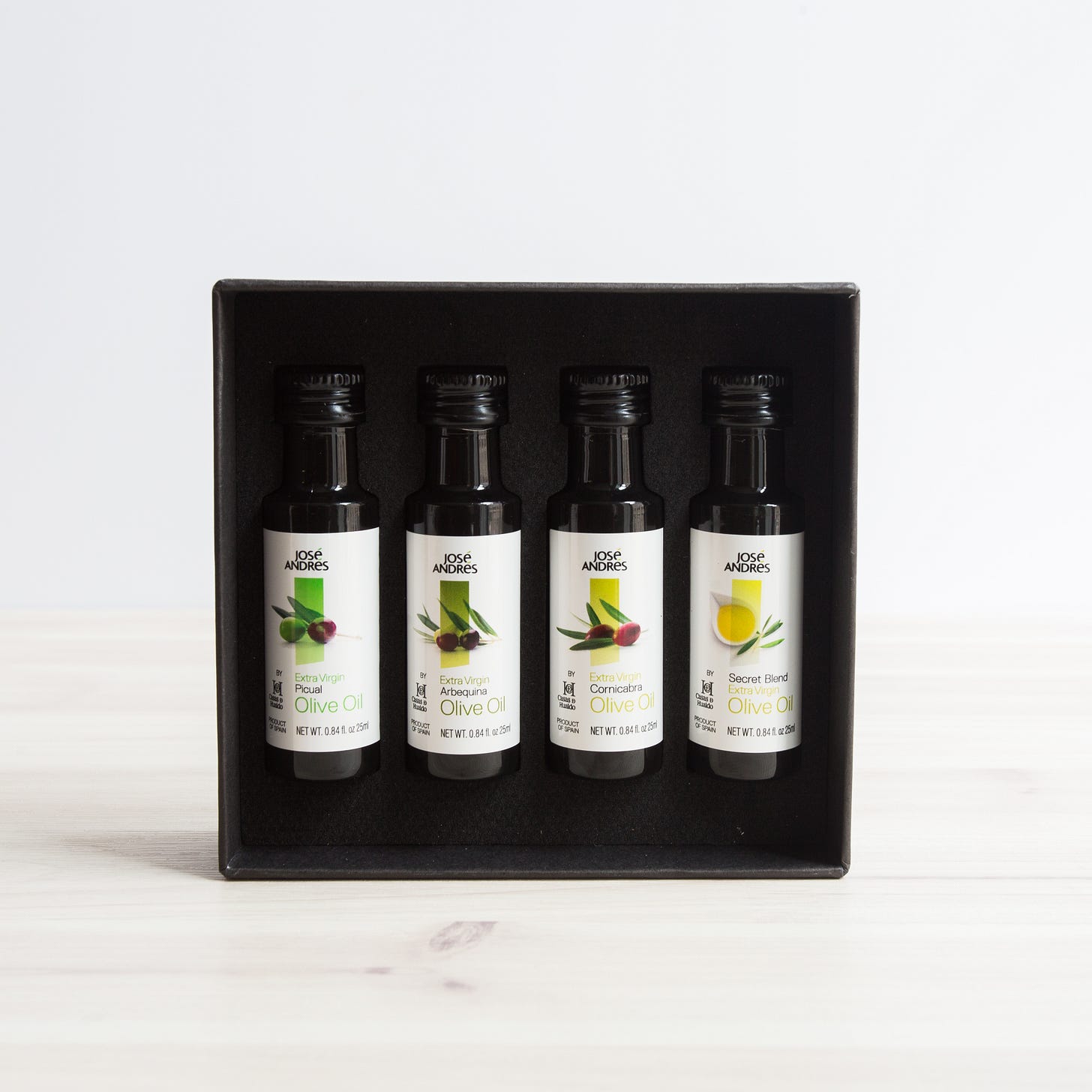Everything You Need to Know about Spanish Olive Oil
It’s the liquid gold that runs through my veins
Amigos,
It is October and that means it is the beginning of the olive harvest in Spain, so I thought I’d talk to you about one of my favorite Spanish ingredients….olive oil!
If you love to cook you probably also love olive oil, one of the most important and necessary ingredients in everyone’s pantry. Every kitchen should have a bottle (or many more!) of olive oil because it’s a great conductor of heat for cooking, but also because it has so many health benefits—it is rich in antioxidants and healthy good fats (the doctors tell me that olive oil’s monounsaturated fats help lower your "bad" LDL cholesterol), and it has properties that help to reduce inflammation. It is delicious and so good for you!
Now why do I love olive oil from Spain? Well, first of all because we are the number one producer of olive oil in the world. And we not only make the most olive oil, but we also make the most delicious! You know I am biased, but even so, I think even if I were not from Spain I would feel the same way! Spanish extra virgin olive oil is like liquid gold, so fresh and fruity that we have it as a simple traditional breakfast with bread…that’s it. You know it’s special if you can make it into a simple two-ingredient breakfast, which so many people in Spain do every morning.
There are other reasons why I love it—one is because Spanish olive trees are some of the oldest in the world…actually, Spain is home to one of the OLDEST olive trees anywhere!! It’s true! You’ll find a 1,700-year old tree near the small town of Ulldecona in southern Catalonia. Many other old trees are growing about a two-hour drive south of Barcelona, in an area called the Mar de Olivas, or Sea of Olives…a beautiful place filled with so much history.
Now, for sure not every tree in Spain is over a thousand years old, but many are hundreds of years old and they have seen so much time passing before them, and when you taste the pure juice that comes from their fruit, wow! You can feel the soil, the rain, the breeze from the sea…it’s almost like a wine.
So which type of Spanish olive oil is the best? Well, that’s hard to say because the country has 340 million olive trees, and 260 different varieties of olives, each with its own flavors and aromas. Extra virgin olive oil blends can be really great as well, they don’t all have to be single-variety. Here are just a few of my favorites for you to try and tell me what you think.
The elegant Arbequina which is from Catalonia is one of the smallest olive varieties. It is grown near the Mediterranean and with that sea breeze it makes a sweet oil with the fruity aroma of fresh herbs and artichoke. This oil is best fresh, drizzled on salads, simply cooked vegetables or grilled fish to take them from good to astonishing!
The Picual is another beautiful one…it is the most abundant variety in Spain and the world. The Picual olive is grown on silvery gnarled branches, has a fruity flavor with hints of green leaves, banana, and mint, with a slight peppery finish. You could use this for dipping toasted bread or vegetables, but it also stands up well in cooking. I love it to sauté fish, or to add an extra layer to savory beef stew or lamb dishes.
As you know, I love telling stories through ingredients and the Cornicabra olive from Toledo, in central Spain, has a great one. For centuries three diverse cultures—Christian, Muslim, and Jewish—have co-inhabited the land and over time this unique variety evolved, which produces a robust olive oil with spicy notes and slightly bitter edge. With its green leaf and apple flavors, I use it in my restaurants to cook rice dishes and seafood, or at home for pasta and paella. It is just as delicious fresh, for sauces and dipping.
I also want to mention the Merula Olive Oil, a very special oil named for the yellow-beaked black bird which populates the Alvarez de Toledo family estate. Merula is a very special olive oil because it is made from the second harvest from the Alvarez de Toledo estate of Extremadura, Spain. The olives for Merula stay on the tree longer than the first harvest (which is used for the Marques de Valdueza oil), giving this oil its flavors of cut grass, green almond, and dried fruit and its buttery mouthfeel. It also gives the oil a higher smoke point, making it perfect for cooking and baking.
I have all of these Spanish olive oils in my shop at Little Spain so you can try them and see what you think! (Definitely leave a comment and let me know!) And if you can’t decide, you can go to my shop here and try the Olive Oil Tasting Kit!
If you are an annual or monthly subscriber, you received a discount code in your welcome email so you can get 15% off a purchase at Little Spain! I’ll also send a reminder on Wednesday with the recipe this week, which is for a vegetable dish preserved in olive oil called Escalivada. Delicious!






This is so helpful. I'm lost on Spanish olive oils and I would like to switch up from my Partanna/ Paisano/Mandranova Sicilian oils. This is a great start for me. Thanks for sharing!
https://www.eleconomista.es/podcasts/noticias/11996296/10/22/La-catastrofe-del-aceite-de-oliva-precios-de-record-por-la-caida-de-produccion.html
Olive Oil prices will duolicate due to the decrease in crop yield due to high temperature and drought. Better buy now and save for future use.